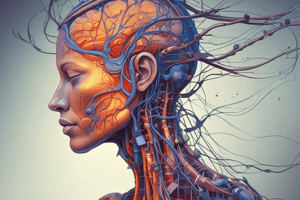Podcast
Questions and Answers
How does the effect of a muscarinic agonist on the lungs contrast with its effect on sweat glands?
How does the effect of a muscarinic agonist on the lungs contrast with its effect on sweat glands?
- The muscarinic agonist stimulates alveolar function while inhibiting sweat production.
- The muscarinic agonist causes broncho-constriction in the lungs and stimulates sweat glands. (correct)
- The muscarinic agonist bronchodilates the lungs while having no effect on sweat glands.
- The muscarinic agonist causes broncho-constriction in the lungs and inhibits sweat glands.
In a scenario where a patient is administered a drug that selectively blocks $N_M$ receptors, which of the following physiological responses would most likely be observed?
In a scenario where a patient is administered a drug that selectively blocks $N_M$ receptors, which of the following physiological responses would most likely be observed?
- Increased gastrointestinal motility and salivation.
- Skeletal muscle relaxation and decreased motor function. (correct)
- Pupil constriction and increased sweating.
- Increased heart rate and bronchodilation.
If a new drug is developed that selectively targets and inhibits adrenergic nerves, what would be the most likely overall effect on the cardiovascular system?
If a new drug is developed that selectively targets and inhibits adrenergic nerves, what would be the most likely overall effect on the cardiovascular system?
- Decreased heart rate and vasodilation due to reduced sympathetic activity. (correct)
- Decreased heart rate and vasoconstriction due to activation of muscarinic receptors.
- Increased heart rate and vasodilation due to unopposed parasympathetic activity.
- Increased heart rate and vasoconstriction due to enhanced epinephrine release.
Explain why a patient with an existing respiratory condition such as severe COPD might experience adverse effects if administered a muscarinic agonist.
Explain why a patient with an existing respiratory condition such as severe COPD might experience adverse effects if administered a muscarinic agonist.
How would the administration of a ganglion blocker impact the balance between sympathetic and parasympathetic tone in various organs?
How would the administration of a ganglion blocker impact the balance between sympathetic and parasympathetic tone in various organs?
Given the physiological effects of muscarinic antagonists, why might these drugs be contraindicated in patients with glaucoma?
Given the physiological effects of muscarinic antagonists, why might these drugs be contraindicated in patients with glaucoma?
What is the potential therapeutic rationale for using a selective muscarinic receptor agonist in patients suffering from post-operative ileus?
What is the potential therapeutic rationale for using a selective muscarinic receptor agonist in patients suffering from post-operative ileus?
A researcher is studying a novel compound that selectively enhances the activity of cholinergic nerves. Which of the following effects would most likely be observed in a healthy subject?
A researcher is studying a novel compound that selectively enhances the activity of cholinergic nerves. Which of the following effects would most likely be observed in a healthy subject?
In a patient experiencing excessive sweating (hyperhidrosis), how would a muscarinic antagonist alleviate this condition, and what potential side effects must be considered?
In a patient experiencing excessive sweating (hyperhidrosis), how would a muscarinic antagonist alleviate this condition, and what potential side effects must be considered?
If an individual accidentally ingests a substance that inhibits acetylcholinesterase, leading to an accumulation of acetylcholine in the synaptic cleft, what immediate physiological responses would be expected?
If an individual accidentally ingests a substance that inhibits acetylcholinesterase, leading to an accumulation of acetylcholine in the synaptic cleft, what immediate physiological responses would be expected?
If a drug is designed to selectively stimulate $N_N$ receptors, what would be the expected effects on both the sympathetic and parasympathetic nervous systems?
If a drug is designed to selectively stimulate $N_N$ receptors, what would be the expected effects on both the sympathetic and parasympathetic nervous systems?
Consider a scenario where a patient is given a medication that results in prolonged activation of adrenergic receptors. What compensatory mechanisms might the body employ to restore homeostasis, and how could these mechanisms affect the drug's long-term efficacy?
Consider a scenario where a patient is given a medication that results in prolonged activation of adrenergic receptors. What compensatory mechanisms might the body employ to restore homeostasis, and how could these mechanisms affect the drug's long-term efficacy?
How do the structural differences between parasympathetic and sympathetic pathways (i.e., preganglionic and postganglionic neuron lengths) influence the specificity and duration of their effects on target organs?
How do the structural differences between parasympathetic and sympathetic pathways (i.e., preganglionic and postganglionic neuron lengths) influence the specificity and duration of their effects on target organs?
If a toxin selectively disrupts the synthesis of norepinephrine in adrenergic nerves, what downstream effects would be anticipated, and how would the body attempt to compensate for this disruption?
If a toxin selectively disrupts the synthesis of norepinephrine in adrenergic nerves, what downstream effects would be anticipated, and how would the body attempt to compensate for this disruption?
In what ways might the effects of a drug that inhibits the reuptake of norepinephrine at adrenergic synapses differ from those of a drug that directly stimulates adrenergic receptors, and what are the implications for therapeutic use?
In what ways might the effects of a drug that inhibits the reuptake of norepinephrine at adrenergic synapses differ from those of a drug that directly stimulates adrenergic receptors, and what are the implications for therapeutic use?
Flashcards
Cholinergic Nerve
Cholinergic Nerve
Nerves that synthesize and release acetylcholine.
Cholinergic Receptors
Cholinergic Receptors
Receptors that bind acetylcholine; includes nicotinic and muscarinic subtypes.
Nicotinic Receptor
Nicotinic Receptor
A type of receptor, that binds acetylcholine, found in ganglia and skeletal muscle.
Muscarinic Receptor
Muscarinic Receptor
Signup and view all the flashcards
Adrenergic Nerve
Adrenergic Nerve
Signup and view all the flashcards
Adrenergic Receptors
Adrenergic Receptors
Signup and view all the flashcards
Nicotinic Agonist
Nicotinic Agonist
Signup and view all the flashcards
Ganglion Blocker
Ganglion Blocker
Signup and view all the flashcards
Skeletal Muscle Relaxant
Skeletal Muscle Relaxant
Signup and view all the flashcards
Muscarinic Agonist
Muscarinic Agonist
Signup and view all the flashcards
Muscarinic Antagonist
Muscarinic Antagonist
Signup and view all the flashcards
Miosis
Miosis
Signup and view all the flashcards
Mydriasis
Mydriasis
Signup and view all the flashcards
Hyperthermia
Hyperthermia
Signup and view all the flashcards
Study Notes
Cholinergic and Adrenergic Terms
- Cholinergic refers to acetylcholine, and adrenergic refers to norepinephrine
Peripheral Nervous System Comparison
- The parasympathetic nervous system has long preganglionic and short postganglionic neurons
- The sympathetic nervous system has short preganglionic and long postganglionic neurons
- Somatic nerves consist of a single, long neuron without ganglia
Neurotransmitters in Different Systems
- In parasympathetic pathways, acetylcholine is the transmitter at both ganglia and the target organ
- In sympathetic pathways, acetylcholine is the first neurotransmitter, followed by norepinephrine from the postganglionic neuron
- Acetylcholine is the transmitter for somatic motor nerves
Cholinergic Nerves and Receptors
- Cholinergic nerves synthesize and release acetylcholine
- Cholinergic receptors are sometimes called "colonoceptors"
Types of Cholinergic Receptors
- Nicotinic receptors have two subtypes: N sub N and N sub M
- Muscarinic receptors are found on parasympathetically innervated organs and sweat glands
Adrenergic Nerves and Receptors
- Adrenergic nerves release norepinephrine
- Dopaminergic nerves release dopamine and are part of the sympathetic nervous system
- Adrenergic receptors include alpha and beta receptors
Dopaminergic Receptors
- Dopamine receptors are classified as D1
- Dopamine's primary function is in the brain, with limited peripheral activity
Autonomic Receptor Knowledge for Predicting Drug Properties
- Understanding the location and function of autonomic receptors is essential for predicting the properties of autonomic drugs
Nicotinic Agonists
- Nicotinic agonists, like nicotine, stimulate nicotinic receptors
- They affect ganglia, adrenal medulla, and skeletal muscle
Nicotinic Antagonists
- Nicotinic antagonists are divided into ganglion blockers and skeletal muscle relaxants
- Ganglion blockers block N sub N receptors
- Skeletal muscle relaxants block N sub M receptors on skeletal muscle
Muscarinic Agonists and Antagonists
- Muscarinic agonists have parasympathetic effects
- Muscarinic antagonists block the parasympathetic nervous system, leading to sympathetic-like responses
Predicting Muscarinic Agonist Effects
- In the eye, muscarinic agonists cause pupil constriction (miosis)
- Muscarinic agonists slow the heart rate, causing bradycardia
- In the lungs, they cause broncho-constriction and should be avoided in patients with asthma or COPD
- These agonists increase GI and urinary motility, promoting waste elimination
- Muscarinic agonists stimulate sweat glands, causing sweating
Predicting Muscarinic Antagonist Effects
- In the eye, muscarinic antagonists dilate pupils (mydriasis)
- Muscarinic antagonists increase heart rate, causing tachycardia
- In the lungs, they cause bronchodilation
- These antagonists decrease GI and urinary motility
- Muscarinic antagonists block sweating and can cause hyperthermia
Blood Vessels
- Blood vessels are primarily innervated by the sympathetic nervous system
- Sympathetic stimulation of blood vessels involves alpha and beta adrenergic receptors, leading to constriction or dilation
- There is no parasympathetic innervation of blood vessels
Studying That Suits You
Use AI to generate personalized quizzes and flashcards to suit your learning preferences.




